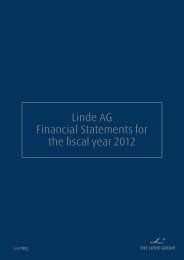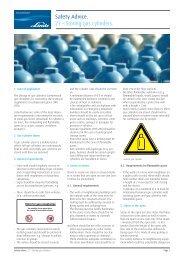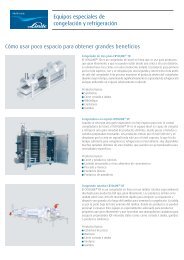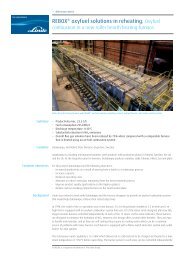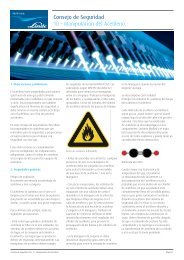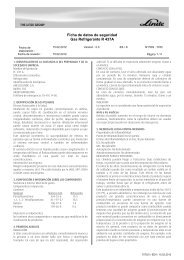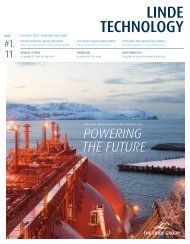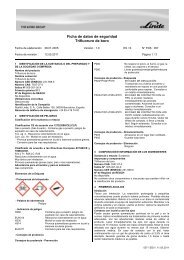Linde Welding Gases Brochure
Linde Welding Gases Brochure
Linde Welding Gases Brochure
- No tags were found...
Create successful ePaper yourself
Turn your PDF publications into a flip-book with our unique Google optimized e-Paper software.
Peak performance throughinnovation and expertise.The <strong>Linde</strong> welding gases.
2 ContentsContents.Advanced technology secures competitiveness. Innovations from <strong>Linde</strong> Gas 3The two product lines – Competence Line and Performance Line 4The <strong>Linde</strong> welding gases at a glance 6Complex properties for specific uses 8CORGON ® : MAG welding of structural steel 10CRONIGON ® : MAG welding of stainless steels 12VARIGON ® : MIG welding of aluminum alloys 14Shielding gases for arc brazing 16VARIGON ® : TIG welding 18VARIGON ® : plasma welding 20Process gases for laser and laser-hybrid welding 21<strong>Gases</strong> for root protection 22<strong>Welding</strong> gases for special materials 24<strong>Linde</strong> Gas supply solutions: efficient and economic 26Information and services 27CORGON ® , CRONIGON ® , LASGON ® , LINDATA ® , LINFAST ® , LIPROTECT ® , LISY ® tec and VARIGON ® are registered trademarks ofthe <strong>Linde</strong> Group.Nicrofer ® is a registered trademark of ThyssenKrupp VDM.
Introduction3Advanced technology secures competitiveness.Innovations from <strong>Linde</strong> Gas.<strong>Linde</strong> Gas is part of the <strong>Linde</strong> Group, a worldwideoperation with two business divisions,Gas & Engineering and Material Handling,each of which occupies a leading marketposition. As such, we are fully committed tothe Group’s claim to leadership. Our company’sguiding principle – to be the “best in class”in every respect – provides us with the necessaryorientation in much the same way asa compass needle indicates the way ahead.This claim is expressed, on the one hand, byinnovations at the product level and, on theother, by the commitment of our employeesworking in all areas, ranging from productionto service. It is this commitment that enables usto earn the confidence of more than 1.5 millioncustomers worldwide. The successful combinationof outstanding engineering services andmarket-oriented entrepreneurship afford us thestrength to consolidate our leading position ona competitive global market.Today, change is one of the few constants thatshape the economy, markets and commercialactivities. Nothing stands still and speed is ofthe essence. Explosive growth in the variety ofmodern welding materials, rapid developmentsin the field of electronics and an informedawareness of occupational health and safetyalso make new demands on shielding gases forwelding. Within this context, productive GMAwelding of nickel alloys as well as arc stabilizationthrough active doping in the shielding gasfor aluminum welding are just two examples ofour successful development work.As a leading supplier of technology, we havea special responsibility to our customers. Wecontinue to uphold the traditions of our founder,Carl von <strong>Linde</strong>, for whom ongoing developmentand progress were a way of life.We owe our great potential to decades of expertise,which continues to be translated intospecific product innovations developed in closecollaboration with our customers. Let our expertisehelp you to invest in new markets, productsand people. Innovations are what we dobest. Day after day.
4 The two product lines – Competence Line and Performance LineA versatile tool in the value-added process.The two product lines – Competence Line andPerformance Line.Competence LineProven gases and gas mixtures offering thevery highest quality and supported by outstanding<strong>Linde</strong> service. This line contains ourall-rounders, such as CORGON ® 18,CRONIGON ® 2 and argon, products that areindispensable to everyday welding technologyand that are ranked amongst some of thebest-selling gas products in the world. However,this line also contains some more recentdevelopments, such as VARIGON ® N2; this is aTIG process gas that has a metallurgical effectfor duplex-steel applications. Or oxygendopedVARIGON ® S, a gas that was speciallydeveloped for aluminum.ReliabilityQualityVersatilityUser-friendliness
The two product lines – Competence Line and Performance Line5In order to achieve both technically andeconomically high-quality weld seams,everything involved in the process – material,equipment, process gas and welding technology– has to do its part. This requires anew attitude towards our products. Shieldinggases are much more than “welding consumablecommodity”, they also:Influence the arc – both electrically andthermallyDetermine viscosity and surface tension –both of the drop and of the poolControl wetting propertiesControl penetration, seam geometry andseam surfaceReact metallurgically with filler metal andpoolInfluence radiation, heat transfer and arcefficiencyDetermine metal transfer and energydistribution in the arcInfluence certain pollutant emissionsThese properties have to be optimally utilized inorder to reap the full potential of gases in thewelding process. Through our understanding ofhow this tool functions, we are able to make anactive contribution towards the added value inour customers’ production processes.Our customers continue to demand specializedsolutions to keep pace with the growing requirementsin the field of welding. Advancesmade in equipment and materials science, newmeasuring technologies and simulation techniquesrequire state-of-the-art, innovative gasproducts. Expensive specialized materials requirecustomized solutions – sometimes even ata molecular level. <strong>Gases</strong> require the same diversificationas materials and joining processes.To improve product transparency and to makeselecting a product easier, we will be offeringtwo product lines in the future. Both lines containshielding gases for every conceivable materialand process combination.Performance LineHighly productive specialists with admixturesof helium or hydrogen. These two componentsimprove arc efficiency and enhanceheat transfer from the arc to the joint, resultingin higher welding speeds. If improvementsin quality alone are required, heliumor hydrogen can be used without increasingthe welding speed. For example, helium canbe used as an additive in many robot applicationsto better compensate for componenttolerances. The wider acting arc improvesedge wetting and reduces lack of fusionproblems.Greater outputImproved qualitySpecializationCustomer-specific
6 The <strong>Linde</strong> welding gases at a glanceThe optimum solution for every application.The <strong>Linde</strong> welding gases at a glance.MAGMIGGMA brazingTIGProcess Material group Competence Line Performance LineMAG Unalloyed steels CORGON ® 18 CORGON ® 10He30Metal active gas Fine-grained structural CORGON ® 10 CORGON ® 25He25steels, pressure-vessel and CORGON ® S5CORGON ® S3He25pipe steels, hot or cold- CORGON ® S8rolled steels, etc. CORGON ® 5S4CORGON ® 13S4Carbon dioxideStainless steels CRONIGON ® 2 CRONIGON ® 2He20Corrosion-resistant, heat- CRONIGON ® S1 CRONIGON ® 2He50resistant, creep-resistant, CRONIGON ® S3duplex steels, etc.Nickel-base metals Argon (MIG process) CRONIGON ® Ni seriesMIG Aluminum, copper, Argon VARIGON ® He seriesMetal inert gas nickel and their alloys VARIGON ® S VARIGON ® HeS seriesGMA brazing Coated and uncoated sheet Argon VARIGON ® He seriesGas metal arc brazing steels, stainless ferritic CRONIGON ® S1 VARIGON ® HeS seriessteels CRONIGON ® 2PAWRoot protectionTIG All fusion-weldable metals, Argon VARIGON ® He15Tungsten inert gas all unalloyed and alloyed VARIGON ® He30steels, non-ferrous metalsVARIGON ® He50VARIGON ® He70VARIGON ® He90HeliumAluminum and its alloys Argon VARIGON ® He seriesVARIGON ® SVARIGON ® HeS seriesAustenitic stainless steels, Argon VARIGON ® H2nickel alloysVARIGON ® H6VARIGON ® He15Duplex and super-duplex Argon VARIGON ® N2He20steelsVARIGON ® N seriesFully austenitic steels Argon VARIGON ® N2H1VARIGON ® N seriesLaserArc stud weldingPAW All fusion-weldable metals Argon VARIGON ® He seriesPlasma arc weldingVARIGON ® H seriesRoot protection All materials for which Argon Forming gas: 5–20 % H 2 in N 2oxidation on the root side Nitrogen VARIGON ® H serieshas to be avoided VARIGON ® N series Observe the safety informationin the specialist literature!Laser All fusion-weldable metals Argon LASGON ® seriesJoining technologiesSpecialty mixturesHeliumArc stud welding Steel CORGON ® 18 CORGON ® 10He30Aluminum Argon VARIGON ® He30S
The <strong>Linde</strong> welding gases at a glance7Competence Line Performance Line EN 439 Carbon Oxygen Nitrogen Helium Hydrogen ArgondioxideVol.- % Vol.- % Vol.- % Vol.- % Vol.- % Vol.- %Argon (Ar) I1 100Helium (He) I2 100Carbon dioxide (CO 2 ) C1 100CORGON ® 10 M21 10 balanceCORGON ® 10He30 M21 (1) 10 30 balanceCORGON ® 18 M21 18 balanceCORGON ® 25He25 M21 (1) 25 25 balanceCORGON ® S5 M22 5 balanceCORGON ® S8 M22 8 balanceCORGON ® S3He25 M22 (1) 3,1 25 balanceCORGON ® 5S4 M23 5 4 balanceCORGON ® 13S4 M24 13 4 balanceCRONIGON ® 2 M12 2,5 balanceCRONIGON ® 2He20 M12 (1) 2 20 balanceCRONIGON ® 2He50 M12 (2) 2 50 balanceCRONIGON ® S1 M13 1 balanceCRONIGON ® S3 M13 3 balanceCRONIGON ® Ni10 M11 (1) 0,05 30 2 balanceCRONIGON ® Ni20 M12 (2) 0,05 50 balanceCRONIGON ® Ni30 S M12 (1) + 5N 2 0,05 5 5 – 10 balanceVARIGON ® N2 S I1 + 2N 2 2 balanceVARIGON ® N3 S I1 + 3N 2 3 balanceVARIGON ® N2H1 S R1 + 2N 2 2 1 balanceVARIGON ® N2He20 S I3 + 2N 2 2 20 balanceVARIGON ® He15 I3 15 balanceVARIGON ® He30 I3 30 balanceVARIGON ® He50 I3 50 balanceVARIGON ® He70 I3 70 balanceVARIGON ® He90 I3 90 balanceVARIGON ® S M13 0,03 balanceVARIGON ® He30S M13 (1) 0,03 30 balanceVARIGON ® H2 R1 2 balanceVARIGON ® H5 bis H15 R1 5 – 15 balanceForming gas 95/5 – 70/30 F2 balance 5 – 30Nitrogen (N 2 ) F1 100Note:• In addition to the above-mentioned shielding gases, other industrial gas mixtures can also be supplied to meet customerrequirements.• Subject to change due to continuing development and in the service of our customers.
8 Complex properties for specific usesOur gases' capabilities grow with your requirements.Complex properties for specific uses.Oxygen doping in the VARIGON ® HeS series facilitateselectron emission at the cathode for MIG-AC welding;the picture shows the wire electrode in the phase ofnegative polarity.An in-depth understanding of the “internalproperties” of gas components and theirinteraction in specialized mixtures is essentialfor successful use of process gases inspecific welding applications. The weldingarc itself, a highly efficient but complex tool,consists largely of different amounts of ionizedgas and metal vapor. This means thephysical properties of the gas have a directand immediate impact on the arc. In addition,the process gases also contact the hotmetal, a highly reactive area, in which thechemical and metallurgical effects of thegases also play an important role. The followingcriteria serve as examples only anddo not claim to be complete.Dissociation and ionization energyIonization occurs directly in the case of themonatomic inert gases, Ar and He. Diatomic orpolyatomic gases, such as H 2 or CO 2 , have to beinitially dissociated in the arc, a process whichrequires additional energy. The less energyrequired for these processes, the easier it is toignite the arc. If components that are comparativelydifficult to ionize, such as He or CO 2 , arepresent, the welding voltage has to be increasedaccordingly. However, this additional electricalenergy is released again in the form of recombinationenergy, which can both improve heatinput and increase welding speed.Thermal conductivitySome of the arc’s heat is transferred to theworkpiece via the plasma or gas flow. Especiallyat high temperatures, the two components Heand H 2 can significantly improve process efficiency.Good thermal conductivity has a positiveeffect on seam geometry, wetting, degassing ofthe molten pool – and on welding speed.Chemical reactivity and metallurgical impactCO 2 and O 2 are both active, oxidizing gases.Especially at high temperatures, they reactquickly with the materials present to formoxides. In appropriate quantities, metal oxidescan improve arc stability; this phenomenon isput to good use, for example, in the VARIGON ®HeS and CRONIGON ® Ni series specialty gases.If larger percentages of active gases are present,for example, when MAG welding structuralsteel, the resulting increase in oxidation generatesadditional heat. The product of oxidation,otherwise known as “slag” or “silicate”, is oftenfound on the surface of the seam. O 2 as a shieldinggas component has a greater oxidizing effectthan the same quantity of CO 2 . If qualitydemands require lower levels of these deposits,the active gas component in the CORGON ® /CRONIGON ® series can be reduced. However,this should only be done if requirements regardingfusion, penetration and the number ofpores are taken into consideration. In the caseof a higher CO 2 content, carbon pickup mayoccur, depending on the metal being used.
Complex properties for specific uses9Dissociation and ionization energy of the gas componentsParameters for ignition properties, welding voltage and arc energyIonization energy, 1st stageDissociation energyThermal conductivity of the gasesHeat transfer from the arc to the base metal depends on the thermal conductivity ofthe different gases. Helium and hydrogen offer particularly high thermal conductivityvalues.Argon (Ar)15.80.16Helium (He)Hydrogen (H 2 )Nitrogen (N 2 )Carbon dioxide (CO 2 )24.64.59.84.313.614.514.4Thermal conductivity [W/cmK]0.120.080.04CO 2H 2HeOxygen (O 2 )5.113.6O 2Ar00510152025302,000 4,000 6,000 8,000 10,000[eV]Temperature [°C]N 2 is considered a low-activity gas, i.e.whether or not reactions take place depends onthe metal and the process conditions. An exampleof positive reactivity is the austenitizingeffect of VARIGON ® N gases when TIG weldingfully austenitic materials or duplex steels. Incontrast, the pore-forming or embrittling effectof N 2 with MAG welding steel is detrimental.H 2 is unique as a particularly effective reducingcomponent for arc welding. It can be used, forexample, in TIG/PAW welding and forming ofaustenitic stainless steels with VARIGON ® Hgases, in other words, in cases in which it isimportant to prevent oxidation of very expensiveand sensitive metals. Owing to their superiorthermal conductivity and additional recombinationenergy, VARIGON ® H gases permitmuch higher TIG/PAW welding speeds thanargon. Unfortunately, these extremely beneficialproperties cannot be used for welding allmetals. For example, H 2 leads to pore formationin aluminum and to cracks in ferritic steels.Thus, H 2 ’s compatibility with a given materialalways has to be tested.Ar and He are the inert gases used in welding.Since they do not react with any metal, theycan be used with all metals that can be fusionwelded.Other relevant propertiesRelative density: influences the positiondependenteffectiveness of the shielding gasHeat transfer coefficient: He can transfer heatto a metal surface much more effectivelythan ArPurity levels and mixing accuraciesShielding gases are standardized in EN 439 andISO 14175. These standards specify, amongstother things, the minimum quality requirementsof the components and mixtures. However,depending on the material, process, methodand quality requirements, higher qualities maybe necessary. In this case, please contact thespecialists at <strong>Linde</strong>.Use of scientific research methods to investigate plasma-physicalprocesses in the arc: section of a spectralanalysis of the MIGp welding process of aluminum withVARIGON ® He30SMetallurgy via process gases: control of austeniteferriteratio when TIG welding duplex steels withVARIGON ® N
10 CORGON ® : MAG-welding of structural steelProven under toughest conditions.CORGON ® : MAG welding of structural steel.Competence LineCORGON ® 10 CORGON ® 18CORGON ® S5 CORGON ® S8CORGON ® 5S4 CORGON ® 13S4Carbon dioxide (CO 2 )Performance LineCORGON ® 10He30CORGON ® S3He25CORGON ® 25He25The collective term “structural steel” refersto unalloyed and low-alloyed steels, finegrainedstructural steels that are suitable forwelding, including tubular and mild steels,unalloyed high-grade steels, as well as otheralloyed steels that are not classified as stainlesssteels. The choice of the most suitableshielding gas depends mainly on the type offiller metal, the material thickness and surfacecondition of the base metals, the degreeof mechanization, working position, arctype and the requirements of the weldedjoint.MAG welding with solid-wire electrodes and gasmixtures, consisting of Argon and CO 2 , such asCORGON ® 18, is by far the most common methodfor joining structural steels. Owing to theirunbeatable advantages in terms of quality andeconomy, gas mixtures are now much morewidely used than pure CO 2 . Thus, the generalrule of thumb applies to how much active gas,CO 2 or O 2 , should be used: as little as possibleand as much as necessary. Due to the increasingdegree of mechanization and the greater use ofpulse techniques, mixed gases with a reducedCO 2 or O 2 content are becoming increasinglypopular.However, a lower level of active gases results inlower heat input, which can jeopardize fusionpenetration and welding performance. In thisrespect, helium admixtures have proven effectivein many applications.A He content of 20–40 % can improve heattransfer from the arc to the component, however,without the known disadvantages of theoxidizing components. The increased efficiencyof CORGON ® He gases can be used either forachieving higher welding speeds or for improvingquality, such as better gap-bridging or forreducing the risk of lack of fusion.MAG high-performance welding is defined inDVS leaflet 0909-1 as a process with a depositionrate of greater than 8 kg/h; this corresponds towire feed rates of more than 15 m/min witha 1.2-mm solid-wire electrode. The LINFAST ®concept offers application-specific, sometimespatented solutions in this highly productivefield. The optimal process, arc type, and shieldinggas type and supply for the task at handshould be selected based on the specific requirements.Whether single-wire, double-wire, strip electrodeor tandem, the targeted use of CORGON ®He mixtures can produce outstanding resultswith very little effort.The shielding gas for metal-cored wires is selectedaccording to the same criteria as thosefor solid-wire electrodes. These cored wires areflexible with regard to special alloying componentsand are characterized by a generally softarc. Thanks to the powder filling, the powerrequired for melting is lower than at comparablemelt-down rate with solid-wire electrodes; thiscan also lead to a lower heat input.Slag-forming flux-cored wires offer advantagesfor certain tasks. For example, when welding outof position, a quickly solidifying slag can act as abacking. By carefully defining the filling composition,the chemical and metallurgical reactionsin the weld pool can be affected. As a rule,CORGON ® 18 or CO 2 is used; lower levels of CO 2are not recommended since penetration canbecome critical.
CORGON ® : MAG-welding of structural steel11Influence of gas components on penetration and seam surface: as an example, a fillet weld on a T-joint, sheet thickness 10 mmFully mechanized MAGp–robot weldments with constant travel- and wire feed speedCORGON ® 10 CORGON ® 18 CORGON ® S5 CORGON ® 10He30Effect of shielding gas composition on the MAG process and resultGas components Ar + CO 2 Ar + CO 2 + He Ar + O 2 CO 2Performance LineCriteriaPenetration in flat Good Good Adequate; good with Goodposition weldingthin sheetsPenetration in out-of- Safer with more CO 2 Safer with more CO 2 Can be critical due to Very safeposition weldingvery liquid weld poolAvoidance of lack-of- Good Improved by He Adequate, risk with Adequatefusion content weld pool flowing aheadDegree of oxidation Decreases with decreasing Decreases with decreasing Higher than comparable High(“slag formation”) CO 2 content CO 2 content gases containing CO 2Pore formation Becomes lower with Becomes lower with Most sensitive Very lowin the weld seam increasing CO 2 content increasing CO 2 contentGap bridging Becomes better with Improved by Good Poordecreasing CO 2 content He contentSpatter ejection Decreases with Decreases with Low spatter Heaviestdecreasing CO 2 content decreasing CO 2 contentNotch effect at weld toe Low Lowest Increases with Highsheet thicknessHeat transfer, heat input Increases with Increases with rising Lowest Highrising CO 2 contentCO 2 or He contentArc types that are Short arc, Spray arc, Short arc, Spray arc Spray arc Short arcparticularly recommended Pulsed arc (max. 25 % CO 2 ) (also high-performance) Pulsed arcPulsed arc (also highperformance)
12 CRONIGON ® : MAG welding of stainless steelsSpecial material properties require special gases.CRONIGON ® : MAG welding of stainless steels.Competence LineCRONIGON ® 2CRONIGON ® S3CRONIGON ® S1Performance LineCRONIGON ® 2He20CRONIGON ® 2He50CRONIGON ® 2He50 for MAG welding of professionalkitchen systems (source: Convotherm)The shielding gases used for stainless steelsdiffer from those used in MAG welding of unalloyedsteels since they contain much less activegases, such as oxygen and carbon dioxide. Thisis necessary to prevent excessive oxidation ofthe passive layer responsible for the corrosionresistant properties of these metals. It is importantto remember that the oxidation propertiesof oxygen are much greater than those of CO 2 .However, welding in an inert atmosphere, forexample, with argon, is not recommendedeither since the pure argon arc is instable andpenetration is significantly decreased.The carbon content of the weld metal is a keyfactor in ensuring resistance to intergranularcorrosion. In stainless steels with particularlylow carbon contents, referred to as ELC steels,the carbon content also of the weld metalshould not exceed 0.03 %. To prevent unacceptablyhigh carbon pickup from the shieldinggas, the CO 2 content of the above-mentionedproducts should be limited to a maximum of2.5 %. If welding is performed correctly, thisprevents sensitization to intergranular corrosion.The graph on the right illustrates the tendencyof various shielding gases to cause thecarburization or decarburization of the weldmetal.These guidelines apply if a solid wire or a metalcoredwire is used as filler metal. However, if aslag-forming flux-cored wire is used, the shieldinggas recommended by the manufacturershould be used. An EN439-M21 shielding gas isusually recommended for these wires, e.g.CORGON ® 18, since the slag that forms preventsoxidation or carbon pickup.Application instructionsAustenitic and ferritic stainless steels are highlysuitable for welding in the short and spray arc.The spray arc range starts at wire feed speedsabout 20 % lower than in welding of unalloyedsteels. The pulse technique offers certain advantagesfor welding high-alloyed materials,particularly with solid wire. It guarantees stable,almost spatter-free metal transfer throughoutthe performance range.Due to their helium content, <strong>Linde</strong>’s PerformanceLine process gases offer improved heatinput and a higher arc temperature. Consequently,it is possible to further increase theproductivity of the MAG process. However, evenif the welding speed is not increased, highlyviscous materials, such as high-alloy CrNiMosteels and nickel-based alloys, also benefitfrom a higher energy input; fluidity and thusalso wetting are improved considerably.
CRONIGON ® : MAG welding of stainless steels13Impact of gases on surface oxidationMAGp fillet welds on stainless steel 1.4301/304, sheet thickness 8 mm, mechanized weldingCRONIGON ® S1 CRONIGON ® 2 CRONIGON ® 2He50For austenitic-ferritic stainless steels, referredto as duplex steels, the same gases are recommendedas for austenites. If duplex steel isused in a particularly corrosive environment,argon-oxygen mixtures are not suitable. Dueto their higher oxidation properties, these gasmixtures would unnecessarily reduce the potentialfor corrosion resistance.Carbon pickup and loss with different shielding gasesCarbon content of the wire electrode: 0.016 %0.07% C0.060.050.0650.040.0390.03ELC-limit0.0260.020.0220.0160.010.0140.016CORGON ® S8CRONIGON ® S1CRONIGON ® 2CORGON ® 5S4CORGON ® 18CO 2Shielding gases at a glanceCRONIGON ® 2 CRONIGON ® S1 CRONIGON ® S3 CRONIGON ® CRONIGON ®2He20 2He50Degree of oxidation Good Good Limited Very good Very goodWetting properties Good Good Good Very good Very good<strong>Welding</strong> speed Good Limited Good Very good Very goodInterpass weldability Good Good Limited Good Very goodSpatter Good Good Very good Good GoodArc stability Good Good Very good Good GoodPenetration Good Limited Good Very good Very good
14 VARIGON ® : MIG welding of aluminum alloysQuality, visible not only in the arc behavior.VARIGON ® : MIG welding of aluminum alloys.Competence LineArgonVARIGON ® SPerformance LineVARIGON ® HeVARIGON ® HeSMaximum productivity: MIGp and MIG tandem welding ofsafety relevant chassis components with VARIGON ®He15S (source: BMW AG)MIG welding of aluminum can be performedin the short, spray or pulsed arc. The advantagesof the pulsed technique are that spatterformation is reduced and a wire electrodewith the next largest diameter can beused. The thicker wire is easier to feed and,at identical melt-down rate, has a smallersurface area. Consequently, fewer impuritiesand less moisture are introduced into theweld seam via the wire.The pulsed arc method can be further subdividedinto direct current pulse and alternatingcurrent pulse since power equipment designedfor both types of processes are now available.<strong>Welding</strong> with pulsed AC enables targeted distributionof the arc energy between the workpieceand the wire electrode. This technologyexpands the range of application of classicalMIG welding of aluminum to include thinnercomponents. It is also much easier to bridgegaps and to use thicker wire electrodes.Argon is by far the most frequently used shieldinggas for MIG welding of aluminum. It hasimpressive all-round properties and can beused for all types of arcs and in all positions.Further improvement can be achieved by usingVARIGON ® S, in which the inert argon is dopedwith small quantities of active components tostabilize the arc. The benefits are improvedseam appearance, more uniform weld ripplingand lower spatter ejection.
VARIGON ® : MIG welding of aluminum alloys15Enhancing performance does not always just mean faster welding speedsExamples of potential quality improvements through the use of specialty gases1.5 mm gap bridging at the lap joint on 1 mm sheets,MIG-AC welded with VARIGON ® He15S and 1.2 mm wireelectrodeDirectional stability of the MIGp arc with VARIGON ®He30S facilitates thick-thin joints, here 3 mm to 8 mmArc stabilization with VARIGON ® S (left) in comparisonwith argon (right)Performance Line gases are used in cases inwhich higher-quality seams and increasedwelding performance are required. All gases inthe VARIGON ® He and VARIGON ® HeS seriescontain helium, which makes the arc hotter,broader and more stable.BenefitsReduced porosityImproved penetration, prevents lack of fusionHigher welding speedsBetter gap bridgingLess/no preheating of thick-walledcomponentsThe more uniform heat input and better directionalstability, facilitates the welding ofcomponents of different thermal conductivity,for example, thick-thin joins or cast nodesReduced notch effect and better distributionof forces thanks to wider, flatter seamsNote on MIG welding with dopedshielding gasesArc voltageWhen using an O 2 -doped gas the arc voltagecan be adjusted to a lower setting with thesame arc length and a constant wire feedspeed.Note on MIG welding with shielding gasescontaining heliumArc voltageA higher helium content requires a higher arcvoltage at identical arc length.Seam geometryA greater helium content results in a broaderand flatter seam at the same welding speed.The “argon finger” is less pronounced and fusionpenetration is rounder and deeper. This isadvantageous, particularly in the case of dynamicloads.Shielding gas volumeHelium is lighter than air. This has to be takeninto account both when measuring throughputand when adjusting the minimum shielding gasvolume.The performance-enhancing effect of heliumcomponents and the arc-stabilizing benefits ofoxygen doping are effectively combined in theVARIGON ® HeS series gases.
16 Shielding gases for arc brazingThe somewhat “colder” joint.Shielding gases for arc brazing.Competence LineArgonCRONIGON ® S1 CRONIGON ® 2Performance LineVARIGON ® HeVARIGON ® HeSGMA brazing of hydraulic components with CuAl8Ni2and VARIGON ® He50 (source: HAWE Hydraulik)Gas metal arc brazing (GMA brazing) is analternative method for joining primarily thin(t < 3.0 mm) sheets that have been coatedfor corrosion protection. This method offersconsiderable advantages over MAG weldingsince an alloy metal with a lower meltingpoint than the base metal is used as fillermetal.Lower heat inputLess burn-off of the coatingCorrosion-resistant, copper-based filler metalMuch less spatter formationAlmost no seam corrosionReduced distortionGood gap bridgingThe right choice of shielding gas can furtherboost these positive properties. In addition tothe shielding gas, other key factors influencingthe quality of the join are the base metal, thetype and thickness of the coating, and the alloyused for the filler metal.Both short and pulsed arc GMA brazing arepossible. Pulsed arc brazing can be furtherclassified as DC pulsed and AC pulsed brazingsince power sources enabling brazing with analternating current have now been availablefor some time. AC pulsed brazing enables anaccurate distribution of energy between theworkpiece and the wire electrode. This is evengentler on the coating and results in evenbetter gap bridging.The shielding gas has a varying effect on thefinal brazing result, depending on the type ofsolder used and the base metal or its surfacecondition. Argon is the universal shielding gasfor GMA brazing since it can be used with allsolders, for all types of arcs and in all positions.It offers impressive all-round properties and alow heat input. The disadvantages of argon area somewhat unstable arc and a tendency towardsporosity. Although the very small gaspockets do not have a negative effect on thestrength of the join, they appear when theseam is being polished. This results in extensivefinishing work, particularly in visible areas.When brazing coated sheets with SG-CuSi3, theresult can be improved by adding active components.CRONIGON ® S1, in particular, but alsoCRONIGON ® 2, stabilize the arc and reduceporosity. The slightly increased heat input incomparison with argon translates into higherprocess speeds and improved wetting.
Shielding gases for arc brazing17Improvement in process stability, seam appearance, and wettingwith robotic GMAp brazing of coated sheets with SG-CuSi3 using CRONIGON ® S1ArgonCRONIGON ® S1When brazing with CuAl alloys, the amount ofactive component content in the shielding gashas to be restricted. However, here too, addingspecific quantities of inert helium can also improvethe final results. Products in the VARIGON ®He and VARIGON ® HeS series improve seamappearance, offer outstanding flow and wettingproperties and, owing to a much higher brazingspeed, also result in a lower heat input.Low melting point of the copper solder enables lower heat input and thus lowerZn vaporization with coated sheets[°C]Melting point1,6001,4001,4601,450Boiling pointMelting pointof wire electrodesca.1,450 °C G3Si1Performance Line shielding gases are also thegases of choice for soldering stainless steel.Since no zinc vapors are produced that disturbthe arc, the above-mentioned advantages areeven more pronounced.1,2001,000800907ca.ca.1,035 °C CuAI8960 °C CuSi3Tungsten inert gas (TIG) or plasma arc (PA brazing)brazing are also possible. Since the tungstenelectrode cannot be used with gases witha high active-component content, only inertargon or gases in the VARIGON ® He /VARIGON ®HeS series can be used.600400200660420Structural steelStainless steel Aluminum Zinc
18 VARIGON ® : TIG weldingFor top quality requirements.VARIGON ® : TIG welding.Competence LineArgonVARIGON ® SVARIGON ® NPerformance LineVARIGON ® HVARIGON ® HeVARIGON ® HeSVARIGON ® N2H1VARIGON ® N2He20TIG – the arc method for top quality results, also in theaerospace industryIn TIG welding, the arc burns between theworkpiece and a non-consumable tungstenelectrode. To protect the electrode and moltenpool from oxidation, both are purged withan inert shielding gas, generally argon. Thiswelding process is suitable for all fusion-weldablemetals. The type of current, polarity andshielding gas used depends on the basemetal. TIG welding can be carried out bothwith and without filler metal.Application adviceThe addition of hydrogen or helium is especiallybeneficial to heat distribution and heat transferin the arc, particularly with TIG welding. ThePerformance Line offers a broad range of specialtygases that, owing to their hydrogen or heliumcontent, enable a distinct increase in productivity.The products in the VARIGON ® H series areprimarily recommended for TIG welding ofaustenitic stainless steels and some nickelbasedalloys. The hydrogen content in the gaspermits more energy to be exchanged in thearc. This, in turn, results in deeper penetrationand/or greater welding speeds. The hydrogencontent may be as much as 15%, although therealistic upper limit for manual welding is 6.5%.As a rule, gases with a higher hydrogen contentare only recommended for mechanized welding,since it is more difficult to control the heatand the pool is very fluid. <strong>Gases</strong> containinghydrogen must not be used to weld aluminumalloys or steels sensitive to hydrogen since thiscan lead to greatly increased porosity or embrittlement.The doped gases VARIGON ® He30S andVARIGON ® S contain argon or helium, as well asa very small amount of oxygen for additionalarc stabilization. These gases can greatly improvewelding results, particularly when usingan alternating current for TIG welding aluminum.The gases in the VARIGON ® N series weredeveloped especially for TIG welding duplexsteels or fully austenitic materials. The additionof nitrogen causes the austenization of theweld metal, which is particularly beneficialwhen TIG welding duplex steel without fillermetal. These gases have also proven valuablefor low-ferrite welding of high-alloy metals inthe chemical industry. It should be noted that,due to its hydrogen content, VARIGON ® N2H1 isnot suitable for duplex steels.Since helium, like argon, is an inert gas, the gasmixtures in the VARIGON ® He series can also beused for aluminum alloys, all types of steel, andfor gas-sensitive metals.
VARIGON ® : TIG welding19VARIGON ® H6 improves speed of welding and penetrationManual welding of stainless steel 1.4301, sheet thickness 4 mmVARIGON ® S for arc stabilization with aluminumMechanized melt run on oxide-free surfaceTIG DC, argon, v s = 13 cm/min TIG DC, VARIGON ® H6, v s = 18 cm/min TIG AC, argon TIG AC, VARIGON ® SCompetence Line Performance Line Material CommentsArgon All fusion-weldable metals Suitable for universal use, minimum purity requirementwith highly reactive materials 4.8VARIGON ® S VARIGON ® He30S Al and Al alloys Improved arc stability and ignition safety with alternatingcurrentweldingVARIGON ® He15 Al and Al alloys Higher heat input due to addition of HeVARIGON ® He30 Cu and Cu alloys Better penetrationVARIGON ® He50Higher welding speedVARIGON ® He70VARIGON ® He90 Al and Al alloys TIG direct-current welding with electrodeHeliumwith negative polarityVARIGON ® H2 Austenitic stainless steels Addition of H 2 results in hotter arcVARIGON ® H6 Ni-base metals Better penetrationVARIGON ® H10Higher welding speedVARIGON ® H15Cleaner seams due to reducing actionVARIGON ® N2 VARIGON ® N2He20 Duplex and super duplex steels Control of the austenite-ferrite ratio in the weld metalVARIGON ® N3Increase in performance due to addition of HeVARIGON ® N2 VARIGON ® N2H1 Fully austenitic steels Suppresses ferrite phase for special requirementsVARIGON ® N3 Increase in performance due to addition of H 2
20 VARIGON ® : plasma weldingGreater power density thanks to constricted arc.VARIGON ® : plasma welding.Competence LineArgonPerformance LineVARIGON ® HVARIGON ® HePlasma-spirally-welded aluminum pipes(Source: <strong>Linde</strong> Engineering)Plasma arc welding (PA welding) differs fromTIG welding in that the arc is constricted bymeans of an additional, water-cooled nozzle.At the same time the electrode is movedbackwards to the inside of the burner. Thisconstricted arc has a much greater powerdensity than a TIG arc.Two gas flows are required for PA welding:inner plasma gas and shielding gas. Argon isgenerally used as the plasma gas. In rare cases,argon with a H2 content of up to 2% is alsoused, but it must be compatible with the metal.The shielding gas is selected according to thesame criteria as for TIG welding. Argon is a verygood all-round gas that can be used with allmaterials. The use of VARIGON ® S when weldingaluminum stabilizes the arc.Performance Line shielding gases are generallyused to increase welding performance.VARIGON ® He gases are suitable for all materials.VARIGON ® H gases have been optimized forhigh-alloy stainless steels and VARIGON ® HeSgases for aluminum.Metals suitable for plasma weldingUnalloyed/low-alloy steelsHigh-alloyed steels: CrNi and CrNiMo (goodfor keyhole methods due to high viscosity ofthe melt)Ni, nickel-based alloysTitanium and its alloysCuNi alloys, CuAluminum and its alloysApplications of this welding method includeChemical equipment manufactureAerospace industryVessel constructionFood industryAutomotive industryDepending on the type of method and performancerange, PA welding can be further classifiedinto micro-plasma welding (0.1–50 A,t = 0.05 –2.5 mm), plasma thick-sheet welding(50–350 A, t = 2.5–10 [12] mm) and plasmakeyhole welding (from 60 A, t > 2 mm).
Process gases for laser and laser-hybrid welding21Where precision and speed meet.Process gases for laser and laser-hybrid welding.Laser welding (Source: TRUMPF GmbH + Co. KG)At high welding speeds, laser welding offerstargeted heat input and low distortion.Mostly laser welding is performed withoutany additional material. However, in somecases this may be necessary due to metallurgicalreasons or to bridge gaps. Steels, lightweightmetals and thermoplastics are suitablefor laser welding.Different types of lasers are used for laserwelding: CO 2 lasers or solid-state lasers(Nd:YAG, diode, fiber or disc lasers). Shieldinggases are essential for high-quality welds,whatever the laser type. Whereas materialconsiderations determine the choice of shieldinggas when using solid-state lasers, whenusing CO 2 lasers, the interaction between theshielding gas and the laser beam also has tobe taken into account.Therefore, helium and gas mixtures containinghelium are used when welding with CO 2 lasers.For example, LASGON ® C1 is used for laserwelding low-alloy or galvanized steels. Argonand mixed gases of LASGON ® quality are usedwith solid-state lasers.Laser-hybrid welding is a combination of laserwelding with an arc process, such as GMA, TIGor plasma. Both processes act simultaneouslyin one molten pool. The choice of shielding gasessentially depends on the arc process and onthe material to be welded. Thus, for low-alloysteel, CORGON ® S3He25 is a good choice toattain a high-quality weld seam for example.
22 <strong>Gases</strong> for root protectionFor top-quality workmanship.<strong>Gases</strong> for root protection.Competence LineArgonNitrogenVARIGON ® NPerformance LineForming gas 95/5 – 70/30VARIGON ® H<strong>Welding</strong> with additional forming gasWhen subjected to high temperatures andatmospheric oxygen, many metals tend tointense oxidation. The oxides generally appearas temper color, for example, withstainless steel or titanium materials. Tempercolors will greatly impair the corrosion resistanceof such metals. Furthermore, severeoxidation will impair the formation of weldroots. Thus, in many cases, the root side hasto be protected against oxygen in order toensure optimum corrosion resistance. Thecareful exclusion of atmospheric oxygen canprevent oxidation and temper colors.Differentiating between two differentpurging methodsIn the case of gas displacement, the backinggas pushes forward the air to be removed,with only little mixing occurring. This principleis conceivable, for example, for large vessels.With this method it is very important to takethe relative density of the backing gas intoaccount. In a – purely theoretical – ideal-casescenario, with this type of purging, only asmuch backing gas is used as that of the volumeto be purged.In the case of dilution purging, the backing gasis distributed uniformly throughout the area andmixes with the air to be removed. The purgingcontinues until the amount of residual oxygenhas fallen below a certain threshold. The amountof shielding gas required is thus several timesthat of the purging volume.Two groups of gases are used for rootprotectionInert or low-activity gases, such as argon ornitrogen (4.6 or higher)Inert or low-activity gases with addedhydrogenThanks to the reducing action of hydrogen,root-shielding gases containing hydrogen offergreater protection against the formation oftemper colors. However, they are not suitablefor all metals. The type of gas used for rootprotection primarily depends on the type ofmetal of the component to be purged. Steelsthat are sensitive to hydrogen or highly reactivemetals, such as titanium, are generally purgedwith argon. Austenitic stainless steels can beprotected with root shielding gases containinghydrogen, for example, with gases from the“Forming gas” or the VARIGON ® H series.
<strong>Gases</strong> for root protection23Relative density of root shielding gases1.41.3Ar mixturesHeavier than air1.21.11.0Air0.9TIG seam, root side , no root protectionLighter than air0.80.7N 2 mixtures0.64 8 12 16 2024% of H 2 by volumeTIG seam, root side, with root protectionApplication adviceThe gases for root protection are standardizedin EN439.Group R (Ar-H 2 mixtures)Group I (Ar or Ar-He mixtures)Group F (N 2 or N 2 -H 2 mixtures)Minimum purging times have to be observed toprevent the formation of temper colors. The requiredpurging time depends on the geometry ofthe component and on the volumetric flow rateof the gas. The recommended value for requiredbacking gas volume for pipelines, for example, is2.5–3 times the geometric volume of the component,calculated from the supply point to thewelding point. Depending on pipe diameter, agas flow rate of 5–12 l/min is recommended. Theuse of a measuring device to measure the residualoxygen content is recommended.To prevent the formation of temper colors,after welding, purging should continue until thecomponent has cooled to a temperature ofbelow approx. 220 °C. If the root of the weld isnot accessible after welding for reworking, aroot shielding gas should be used when tackingthe component since temper colors will not bedissolved by welding over the tack point.In the case of Ti-stabilized stainless steels, gasescontaining N 2 cause a clearly visible yellowingof the root of the weld as a result of the formationof titanium nitride. With duplex and superduplexsteels, using root-shielding gases thatcontain nitrogen or pure nitrogen improvescorrosion resistance.Safety informationRoot shielding gases with a hydrogen contentof more than 4 % can form explosive mixturesif they come into contact with air or oxygen.Users must take certain precautionary measuresto prevent the formation of such gasmixtures. For safety reasons, DVS leaflet 0937recommends burning-off if the hydrogen contentin the root shielding gas is 10% or higher.When forming large, closed components,adequate ventilation must be available beforeinspection to prevent the risk of suffocation.When working in small rooms, oxygen depletionshould be taken into account.Root shielding gases for various materialsShielding gasMaterialArgonAll fusion-weldable metalsVARIGON ® H series Ar-H 2 mixtures Austenitic stainless steelsForming gas N 2 -H 2 mixtures Austenitic stainless steels (not Ti-stabilized)Unalloyed steels (not high-strength fine-grained steels!)VARIGON ® N Ar-N 2 mixtures Austenitic stainless steels (not Ti-stabilized)series N 2 Duplex and super duplex steels
24 <strong>Welding</strong> gases for special materialsPractical solutions for extraordinary materials.<strong>Welding</strong> gases for special materials.Competence LineArgonVARIGON ® NPerformance LineVARIGON ® HeCRONIGON ® Ni10CRONIGON ® Ni30VARIGON ® HeSCRONIGON ® Ni20MAGp arc under CRONIGON ® Ni30The group of so-called special metals is notclearly defined. In general, special materialsare defined as materials that are not considered“standard” materials, such as aluminum,structural steel or stainless steel. These specialmetals include nickel-based metals, copperor magnesium, as well as reactive metalssuch as titanium, tantalum and zirconium.Reactive materials: Ti, Ta, ZrTitanium, tantalum and zirconium are termedreactive materials since they react readily withO 2 , N 2 and H 2 . These processes are promoted bythe heat generated during welding. Picking upeven tiny quantities of atmospheric gases canlead to the total embrittlement of the weldseam. This embrittlement cannot be reversedby heat treatment. Under the influence of heat,oxygen also causes greater surface oxidation,which severely affects the corrosion resistanceof these materials. The use of appropriate gasprotection during welding is the most importantfactor in protecting such valuable materialsfrom these negative influences.TIG welding, generally with pure argon asshielding gas, is the most common weldingprocess used for such materials. Purity shouldbe at least 4.8 (99.998 %). Inert He mixtures,such as VARIGON ® He30, can also be used forthicker walls and for improved penetration.Nickel metalsIn the case of nickel alloys, the choice of asuitable shielding gas greatly depends on thetype of alloy to be welded. A variety of nickelalloys are available on the market, which, dependingon their area of application, vary greatlyin terms of their metallurgical properties andsuitability for welding. As a result, there arealso a number of different recommended gases.Users should contact <strong>Linde</strong> Gas or the materialmanufacturer if there is any doubt as to whichgas to use.TIG weldingMany nickel alloys can be easily welded usingargon-hydrogen mixtures, e.g. VARIGON ® H2.Other materials, for example, those that areparticularly susceptible to hot cracks, are betterprocessed with pure argon. However, for metallurgicalreasons, some high-temperature nickelbasedalloys require the addition of nitrogen tothe shielding gas, e.g. VARIGON ® N2.
Shielding gases for special materials25Production of a furnace roll made of Nicrofer ® 6025HT/alloy 602CA with CRONIGON ® Ni30.(Source: H. BUTTING GmbH & Co. KG)MAG weldingThe gases in the CRONIGON ® Ni series werespecially developed for MAG welding of nickelbasedmaterials. These patented gas mixturesare all doped with CO 2 . This minute amount ofCO 2 stabilizes the arc perceptibly without impermissiblyaltering the carbon content of the weldmetal.CRONIGON ® Ni10 and CRONIGON ® Ni20 alsocontain hydrogen or helium, which improvesflow properties and seam appearance and atthe same time, maintains the material’s corrosionresistance.CRONIGON ® Ni30 was developed especially forMAG welding of the high-temperature alloy602CA. In addition to CO 2 doping, this gas containshelium and nitrogen. The latter clearlyreduces the risk of hot cracking during welding.Copper metalsCopper and most copper alloys are characterizedby very high thermal conductivity. To compensatefor the rapid dissipation of weldingheat, gases containing helium are recommendedfor use with these metals. VARIGON ® He30or VARIGON ® He50 are the gases of choice forboth TIG and for MIG welding, particularly ifpre-heating can be reduced as a result of theiruse. To prevent the risk of hydrogen brittlenesswhen welding copper, shielding gases containingH 2 should not be used.Magnesium metalsInert gas mixtures, namely argon, helium andtheir compounds, are used for gas-shielded arcwelding of magnesium alloys. Argon can beused for all welding methods, apart from TIGdirect current. However, VARIGON ® He mixturesare generally recommended as shielding gas asthey can reduce pore formation.Only shielding gases with very high heliumcontent, such as VARIGON ® He90 or pure helium,can be used for TIG DC welding of magnesiumwith the electrode at negative polarity. Otherwise,there will be not enough heat for welding.In the case of MIG welding, due to the highelectrical resistance of magnesium and theassociated heating of the free end of wire, theamount of energy that can be transferred in thewire is limited. This can be somewhat compensatedfor by using a welding gas that containshelium. In addition to the classical pulsed andshort arc processes, MIG welding has recentlyalso been carried out in the form of specialpulsed or controlled short arc welding.VARIGON ® He mixtures can also be used withthese methods to reduce pore formation.
26 <strong>Linde</strong> Gas supply solutions<strong>Linde</strong> Gas supply solutions:efficient and economic.State-of-the-art production facilities, regularquality checks and a national supply networkoffer maximum supply reliability.Our supply channels are both diverse and economical.<strong>Linde</strong> offers the right quantity at theright price for every customer: from small 10-liter cylinders to 75,000-liter liquid tanks. Thecompany’s dense supply network, its manyproduction sites and comprehensive productlines guarantee high product availability, transportsafety, short delivery channels for selfserving customers.Caution: new color-codingIn accordance with the new standard EN 1089part 3, cylinders are color-coded on the shoulder.As the standard has a changeover perioduntil 2006, cylinders with the old color-codingmay be still in circulation until this time. Forfurther information on the changeover to thenew color-coding system, please contact the<strong>Linde</strong> Distribution Center.In addition, <strong>Linde</strong> also offers safe, economicaland functional central gas supplies. We planand manufacture these to your own individualrequirements.Total Gas ManagementWould you prefer to sit back and turn over allyour gas business to a safe and reliable partner?When it comes to supplying gas, servicing,maintenance or safety, our Total Gas Managementteam takes care of it all.Steel cylindersCylinder bundleUpright tanksCapacity Filling*Liter m 310 2.1–2.420 4.0–4.750 9.1–11.8* Content gaseous, filling quantity of the cylinderdepends on the type of gas.Content* m 3 106.8–141.6* Content gaseous, filling quantity of the bundledepends on the type of gas.Content600–75,000 l
Information and services27Information and services.LISY ® tecLISY ® tec is a system for supplying oxygen,acetylene and welding gases in cylinders thatcombines a high level of safety with great easeof use. The ergonomic valve protection deviceallows for easy handling of the cylinder andprotects the fittings from damage. The built-in,two-stage pressure regulator enables almostconstant working pressures. LISY ® tec saves youthe expense of having to buy and install yourown pressure regulator.LIPROTECT ® – a comprehensive safety programfor handling gasesLegal requirements regarding the safe handlingof gases are becoming increasingly strict. TheGerman Workplace Safety Ordinance 2002 andthe Pressure Equipment Ordinance 2002 haveincreased safety requirements for operators ofgas equipment. More than ever before, safety isbeing viewed as the responsibility of the operator.LIPROTECT ® offers you a complete safetyprogram for handling gases.Special editionsApplication Technology Criteria for Orbital TIG<strong>Welding</strong> of Electropolished High-Alloy SteelTubes (156)Shielding gas for <strong>Welding</strong> and Purging-Factors to be taken into account (158)Control of the Arc <strong>Welding</strong> Process inManufacturing (03/90)Gas-Shielded Arc <strong>Welding</strong> of Aluminum(22/93)Pulsed MAGM <strong>Welding</strong> of Nickel Alloy(34/97)TIG <strong>Welding</strong> of Aluminum Alloys (38/97)A Choice of Shielding <strong>Gases</strong> for <strong>Welding</strong> theVariety of Steel Grades (04/99)Hydrogen in the Shielding Gas (11/99)Shielding <strong>Gases</strong> for <strong>Welding</strong> and Root Shieldingof Chrome Nickel Steels (42/01)Duplex Steels: A special Set of RulesCurrent Process Variants of High-PerformanceMAG <strong>Welding</strong>Influence of shielding gases on corrosionproperties of nickel alloy weldments<strong>Brochure</strong>sPerformance Line. Next-level gas-shieldedarc weldingCentralized Gas Supply SystemsLASERLINE ® . The perfect solution for aperfect gas supplyTank Installations for the Supply ofLiquefied <strong>Gases</strong>People creating solutions for people.International Research and Development by<strong>Linde</strong> GasToolsSlide rule: MAG welding with CORGON ®gas mixturesLINDATA ® slide rule: weld seam withCORGON ® mixed-gas weldingLINDATA ® slide rule: CRONIGON ®for CrNi steelsTips for practitioners(on request)Safety trainingSafety servicesSafety productsData sheetsSafety data sheets (on request)Safety instructions (on request)Also available from www.linde-gas.de
Getting ahead through innovation.With its innovative concepts, <strong>Linde</strong> Gas is playing a pioneering role in the global market. As a technology leader, it is our taskto constantly raise the bar. Traditionally driven by entrepreneurship, we are working steadily on new high-quality productsand innovative processes.<strong>Linde</strong> Gas offers more. We create added value, clearly discernible competitive advantages, and greater profitability. Eachconcept is tailored specifically to meet our customers’ requirements – offering standardized as well as customized solutions.This applies to all industries and all companies regardless of their size.If you want to keep pace with tomorrow’s competition, you need a partner by your side for whom top quality, processoptimization, and enhanced productivity are part of daily business. However, we define partnership not merely as beingthere for you but being with you. After all, joint activities form the core of commercial success.<strong>Linde</strong> Gas – ideas become solutions.43487670 0206 – 1.2 Au Subject to change.<strong>Linde</strong> AG<strong>Linde</strong> Gas Division, Seitnerstrasse 70, 82049 Höllriegelskreuth, GermanyPhone +49.89.74 46-0, Fax +49.89.74 46-12 30, www.linde-gas.com




